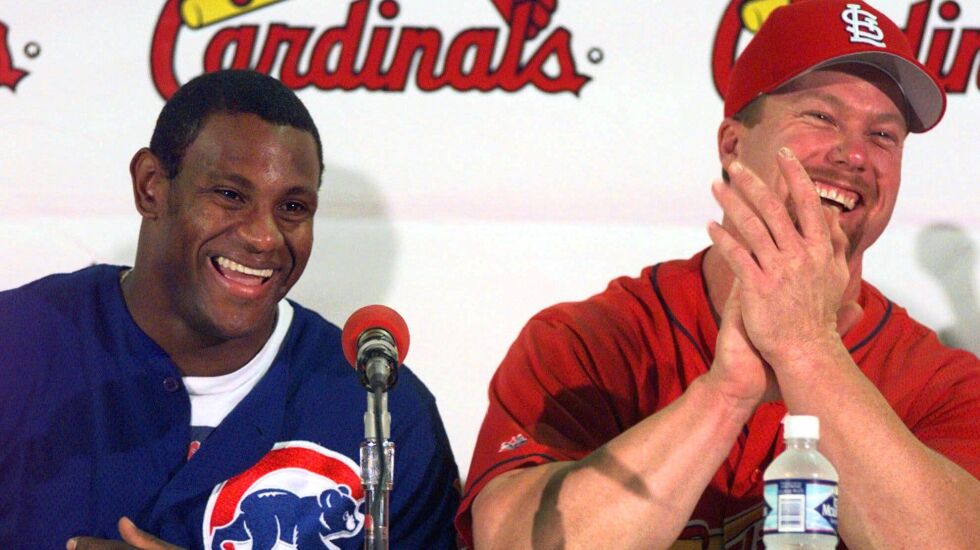
A quarter century has passed since baseball’s magical home run summer of 1998. The neck-and-neck race between the St. Louis Cardinals’ Mark McGwire and Chicago Cubs slugger Sammy Sosa was electric. But that special summer was soon linked to steroids and, of all people, Stephen Jay Gould, an acclaimed Harvard evolutionary biologist and dinosaur expert.
Dinosaurs? Gould studied evolution and dinosaurs, but he was also known for math, statistics, and a devotion to the New York Yankees. He became an expert on baseball statistics. His “Gould’s Law” states that as activities mature and expand, their statistics gravitate toward the mean, which helps explain the idea that when something disappears, it seldom re-emerges — like .400 hitters, and multiple 60+ home run hitters in one season.
Gould concluded that aberrant sports achievements are more likely to occur early in the evolution of a given sport, which explains why there are no .400 hitters left in baseball, why Wilt Chamberlain’s 100-point single-game scoring record came early in the NBA (1962), and why track and field records are now broken in miniscule increments.
Baseball’s evolving game
From 1911 to 1930, league leaders batted over .400 nine times. Ted Williams did it once more in 1941 when he hit .406. It never happened again. Baseball was maturing.
Gould’s approach shows that 1998 was a statistical baseball aberration unexplained by the normal evolution of the game. In the early days of baseball, there was a jump in home runs led by Babe Ruth hitting for power in the 1920s. Overall, he led in homers 12 times in 14 years, hitting 59 and 60 along the way. Leaders in both leagues only managed to hit 50 homers five more times until Roger Maris hit 61 in 1961. After that, no American league player would get to 50 again until 1990 (Cecil Fielder).
Applying Gould’s Law, the steroid era can be tracked from about 1995 to 2002, when on 10 occasions the league-leading sluggers hit between 50 to 73, the Barry Bonds record set in 2001. Remarkably, in 34 years from 1927 (Ruth) to 1961 (Maris), the 60 home run plateau was reached only twice. But from 1998 to 2001, it happened six times, including three times in four seasons by Sosa alone.
A chart of home-run leaders and total league home runs reveals the norms and aberrations over time. In 1901, the first year of a combined American and National Leagues, players hit a total of 455 homers. The total never reached 600 until 630 in 1920, when Ruth clubbed 54 and more players emulated the Babe by turning on the ball for more power. With many more teams and a greater emphasis on the long ball, total homers blew through 5,000 in 1998 and stayed over 5,000 until dipping in 2007. But the league-leading individual homers plunged from 73 in 2001 to the 50s, 40s, and even 30s, until the massive Aaron Judge crushed an American League record 62 in 2022.
Long ball antics changed history
Steroids or not, the 1998 home run chase was an exciting season. McGwire began hot, then Sosa clubbed 20 home runs in June. McGwire was the first to break the Maris record with 62 on Sept. 8. But Sosa got hot again and became the first ever to hit 66 on Sept. 25. McGwire matched Sosa’s 66 later that day, then hit two on Sept. 26 and two more on Sept. 27 to become the first to reach 70.
Eventually McGwire publicly admitted to using steroids and human growth hormone. Sosa never admitted steroid use, but he reportedly tested positive once in 2003.
When MLB finally tested for steroid use in 2003, the official MLB record books were already overrun with home runs. Baseball has left them intact. There is no allegation that steroids were involved with the new Aaron Judge mark, part of the charm behind his impressive effort. But those older records from the steroid era remain, whether tainted or not.
The long ball antics of Sosa and McGwire in 1998 changed the record books and baseball history. We can argue about who took what drugs and when, if ever. But history needs to look no further than Gould’s Law to find a statistical marker that exposes the steroid era for what it was: a visibly unnatural aberration.
Those records still exist, yet the stars who hit them have been frozen out of the Hall of Fame. Something needs to give.







